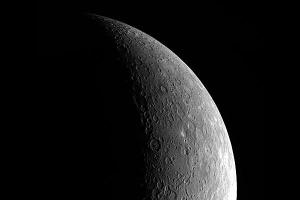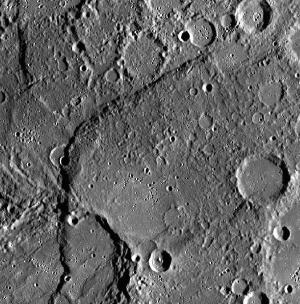Blog
Icy Hot
26 March 2014
 NASA
NASAMercury is the closest planet to the Sun. You might think that means it is also the hottest planet, but that award goes to Venus with its thick, heat-trapping atmosphere. Mercury can be listed as one of the hottest planets in the solar system, but also one of the coldest. This is because Mercury doesn’t have an atmosphere to speak of. So the side of Mercury facing the Sun can reach temperatures of 700 K (800 F/430 C), while the dark side of Mercury cools to 100 K (-280 F/-170 C). Mercury is an icy-hot world.
It was long thought that Mercury might be tidally locked due to its proximity to the Sun, with a single side facing the Sun. We now know that isn’t the case. Instead, the planet rotates in a 3:2 resonance with its orbit. This means that two Mercurian years last three Mercurian days. Because Mercury’s orbit is rather elliptical, the path of the Sun through Mercury’s sky is rather complex. Mercury rotates at a relatively constant rate, but its orbital motion speeds up and slows down due to its orbital eccentricity. This means that the motion of the Sun is generally East to West, as it is on Earth, but there are times when the Sun can be seen to stop, move West to East for a while, then stop and return to its general East-West motion.
 NASA
NASAWe also know that despite the Sun’s heat, the planet is gradually cooling. Mercury is not a large world, and so its interior can’t maintain its internal heat. As the planet slowly cools, it also gradually shrinks. We see evidence of this in long scarps across its surface. These look like long cliffs, but they cut across craters and other features, indicating that they were formed at a later time. As the planet cools and shrinks, its surface wrinkles, forming these scarps.
Being so close to the Sun, it’s rather difficult to get to. More difficult than Mars or even the outer planets. The first probe to orbit Mercury was Messenger in 2011, and it was only then that we could get a complete map of its surface. We’re still learning a great deal about Mercury.
Up next: Venus